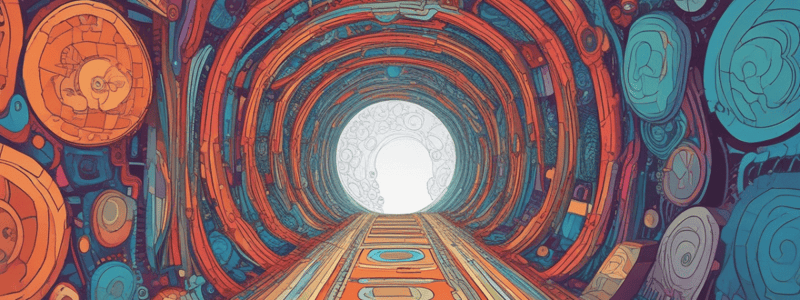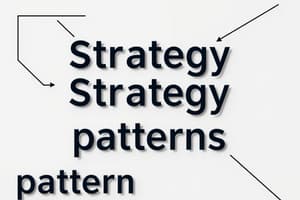Podcast
Questions and Answers
What is the primary benefit of the client only being aware of the abstract Chair interface?
What is the primary benefit of the client only being aware of the abstract Chair interface?
- It restricts the client to only use a single type of chair
- It allows the client to create concrete factory objects
- It enables the client to treat all chairs in the same manner, regardless of their type (correct)
- It forces the client to know the specific type of chair being returned
What is the purpose of the application selecting the factory type during the initialization stage?
What is the purpose of the application selecting the factory type during the initialization stage?
- To decide which abstract interface to use
- To determine the type of chair to be created
- To ensure the correct factory object is created based on the configuration (correct)
- To configure the environment settings for the factory
What is the relationship between the type of chair and the type of sofa or coffee table produced by the same factory object?
What is the relationship between the type of chair and the type of sofa or coffee table produced by the same factory object?
- They are always the same (correct)
- They are always different
- They are unrelated
- They are sometimes the same
What is the role of the sitOn method in the abstract Chair interface?
What is the role of the sitOn method in the abstract Chair interface?
What is the main difference between the Factory Method pattern and the Abstract Factory pattern?
What is the main difference between the Factory Method pattern and the Abstract Factory pattern?
What is a key principle to keep in mind when designing a system to accommodate multiple product families?
What is a key principle to keep in mind when designing a system to accommodate multiple product families?
What is the primary role of an Abstract Factory interface?
What is the primary role of an Abstract Factory interface?
What is the main benefit of using an Abstract Factory pattern in the context of furniture vendors?
What is the main benefit of using an Abstract Factory pattern in the context of furniture vendors?
What is the purpose of declaring interfaces for each distinct product in the Abstract Factory pattern?
What is the purpose of declaring interfaces for each distinct product in the Abstract Factory pattern?
How does the client code interact with the products and factories in the Abstract Factory pattern?
How does the client code interact with the products and factories in the Abstract Factory pattern?
What is the primary difference between the Abstract Factory pattern and the Factory Method pattern?
What is the primary difference between the Abstract Factory pattern and the Factory Method pattern?
What is the role of a factory class in the Abstract Factory pattern?
What is the role of a factory class in the Abstract Factory pattern?
What is the main advantage of using the Abstract Factory pattern over the Builder pattern?
What is the main advantage of using the Abstract Factory pattern over the Builder pattern?
What is the critical aspect that ensures the client code can work with any type of chair without modification?
What is the critical aspect that ensures the client code can work with any type of chair without modification?
What is the primary reason for selecting a factory type based on configuration or environment settings?
What is the primary reason for selecting a factory type based on configuration or environment settings?
Which creational pattern is most similar to the Abstract Factory pattern in terms of product family creation?
Which creational pattern is most similar to the Abstract Factory pattern in terms of product family creation?
What is the main difference between the Abstract Factory pattern and the Builder pattern?
What is the main difference between the Abstract Factory pattern and the Builder pattern?
Why is the Abstract Factory pattern more suitable for systems with multiple product families than the Factory Method pattern?
Why is the Abstract Factory pattern more suitable for systems with multiple product families than the Factory Method pattern?
Study Notes
Abstract Factory Pattern
- The pattern is used to create individual furniture objects that match other objects of the same family, without changing the core code.
Problem
- Furniture vendors update their catalogs frequently, making it necessary to create new products or families of products without altering the existing code.
- Customers expect matching furniture, so it's essential to create objects that fit together seamlessly.
Solution
- Declare interfaces for each distinct product of the product family (e.g., Chair, Sofa, CoffeeTable).
- Make all product variants follow these interfaces (e.g., ModernChair, VictorianChair, ArtDecoChair).
- Declare an Abstract Factory interface with creation methods for all products (e.g., createChair, createSofa, createCoffeeTable).
- These methods return abstract product types represented by the interfaces (e.g., Chair, Sofa, CoffeeTable).
Factory Classes
- Create a separate factory class for each product variant, based on the AbstractFactory interface.
- Each factory class returns products of a particular kind (e.g., ModernFurnitureFactory returns ModernChair, ModernSofa, ModernCoffeeTable).
Client Code
- The client code works with factories and products via their abstract interfaces.
- The client code doesn't need to know the factory's class or the product variant it receives.
- The client treats all products in the same manner, using the abstract interface (e.g., Chair interface).
Benefits
- The client code is decoupled from the factory and product classes.
- The client receives a product that always matches the type of other products produced by the same factory object.
Factory Object Creation
- The application creates a concrete factory object at the initialization stage.
- The app selects the factory type depending on the configuration or environment settings.
Abstract Factory Pattern
- The pattern is used to create individual furniture objects that match other objects of the same family, without changing the core code.
Problem
- Furniture vendors update their catalogs frequently, making it necessary to create new products or families of products without altering the existing code.
- Customers expect matching furniture, so it's essential to create objects that fit together seamlessly.
Solution
- Declare interfaces for each distinct product of the product family (e.g., Chair, Sofa, CoffeeTable).
- Make all product variants follow these interfaces (e.g., ModernChair, VictorianChair, ArtDecoChair).
- Declare an Abstract Factory interface with creation methods for all products (e.g., createChair, createSofa, createCoffeeTable).
- These methods return abstract product types represented by the interfaces (e.g., Chair, Sofa, CoffeeTable).
Factory Classes
- Create a separate factory class for each product variant, based on the AbstractFactory interface.
- Each factory class returns products of a particular kind (e.g., ModernFurnitureFactory returns ModernChair, ModernSofa, ModernCoffeeTable).
Client Code
- The client code works with factories and products via their abstract interfaces.
- The client code doesn't need to know the factory's class or the product variant it receives.
- The client treats all products in the same manner, using the abstract interface (e.g., Chair interface).
Benefits
- The client code is decoupled from the factory and product classes.
- The client receives a product that always matches the type of other products produced by the same factory object.
Factory Object Creation
- The application creates a concrete factory object at the initialization stage.
- The app selects the factory type depending on the configuration or environment settings.
Studying That Suits You
Use AI to generate personalized quizzes and flashcards to suit your learning preferences.
Description
This quiz covers design patterns in object-oriented programming, focusing on creating individual objects that match others of the same family, without changing the core code.




